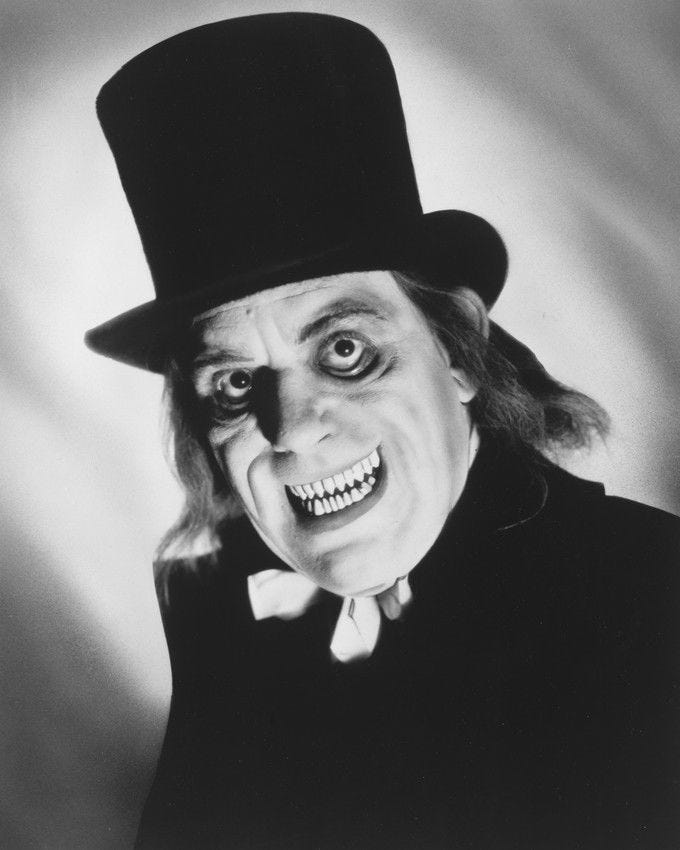The Man of a Thousand Faces
"See! Feast your eyes, glut your soul on my cursed ugliness! Look at Erik’s face! Now you know the face of the voice! You were not content to hear me, eh? You wanted to know what I looked like?"
During the silent film era, some American movie stars curated a performance personality that film writers wrote around. Think Charlie Chaplin's Little Tramp character, who, with his bumbling sweet personality and oversized clothes, featured in 26 films. There’s really nothing like this happening in modern times — the only example I could think up was the Madea films.
While characters like Charlie Chaplin's Tramp were distinguishable partially due to their costuming, Lon Chaney's fame was in due to his ability to transform between roles, unrecognizable under layers of makeup and unique physical performances. Unique to today, Chaney did his own effects makeup.
Lon Chaney started his performance career on the Vaudeville circuit where he met his future wife, Frances Cleveland Creighton, and honed his makeup and performance skills. His son, Creighton Tull Chaney (aka Lon Chaney Jr.) was born in 1906.
Chaney moved to California in 1910, divorcing Frances in 1913, and starting his film career. Chaney started as a contract actor for Universal studios in 1915 and married Hazel Bennett Hastings that same year. He worked and had success on a series of films called Piper’s Price, which had 13 sequels produced in 2 years. Movie making was a different beast a century ago. In this era, studios hired personnel on a contract which seems to have had a weekly pay — so it behooved the studios to squeeze as much out of their talent as quickly as possible.
Chaney left Universal Studios in 1917 after being denied a raise. In 1918 he had his ‘big break’ as an independent performer in the silent western film Riddle Gawme playing the villain. In that same year he received some acclaim playing The Frog, a conman, in the lost film Miracle Man.
Over the next two decades, Chaney would play in nearly 150 films. Throughout the 1920s, Chaney portrayed many iconic roles that required grueling costume and complex makeup. He was a frequent collaborator with director Tod Browning (of Freaks (1932) fame).
He played Quasimodo in The Hunchback of Notre Dame (1924) and Erik in The Phantom of the Opera (1925). Studios did not have dedicated makeup departments in the silent era, and Chaney’s versatility not only as a performer but also in makeup and costuming made him an asset. This also allowed him to double cast — playing multiple roles in the same picture. It’s worth noting that Chaney’s makeup talents were sometimes used to unsavory ends — like when he did yellowface in Shadows (1922).
One of my favorite looks of Chaney’s is from London After Midnight (1927).
London After Midnight’s last known copy was destroyed in a 1965 MGM studio fire. In 1935 Todd Browning remade the film as a talkie called Mark of the Vampire — which, until the invention of time travel, is your best bet of seeing the film.
The only talking picture Chaney did was in 1930. Chaney received praise for his performance in The Unholy Three (1930). Chaney had as versatile a voice as a face- and played a ventriloquist and Mrs. "Granny" O'Grady, the head of a gang who operates a talking parrot pet shop as a front for the operation.
Film critic Alfred Eaker said of Chaney’s performance, "the drag persona with depth of feeling. Chaney never camps it up and delivers a remarkable, multifaceted performance.".
It’s easy to imagine that Chaney could have been a rare instance of a silent film star surviving the transition to synchronized sound — except that he died a month after The Unholy Three’s release. Lon Chaney died in 1930 at the age of 47 of throat cancer.
Many of Chaney's characters have disabilities and disfigurements. His contemporaries made a great deal of the fact that Lon Chaney's parents were both deaf, and Chaney and his siblings knew sign language in addition to English. Reviews and articles of the time often conflate Chaney with his characters, projecting disability upon the man. Chaney gave very few interviews and did not like being photographed outside of makeup and costume, which only fed this mythology.
Chaney's privacy and the attitudes of the time make it impossible to parse Chaney's personal relationship with disability or if he himself identified as disabled. Horror films have a long troubled history of casting characters with disabilities in villainous or shallow roles, often conflating disability with being dangerous. But this is complicated and many films featuring unique, disabled, and disfigured characters cast these characters as sympathetic, empowered, or victimized. While Chaney's characters are generally sympathetic, it is worth noting the horror genre's troubled relationship with mental illness and disability (Fusco, 2018).
Sources:
Fusco, K. (2018). Feast Your Eyes, Glut Your Soul: Lon Chaney, Tod Browning, Disfigurement, and the Limits of Redemptive Affects. Cinema Journal, 57(4), 47–70. https://doi.org/10.1353/cj.2018.0051
Wikipedia contributors. (2024, April 21). London After Midnight (film). In Wikipedia, The Free Encyclopedia. Retrieved 15:11, May 17, 2024, from https://en.wikipedia.org/w/index.php?title=London_After_Midnight_(film)&oldid=1219984435




